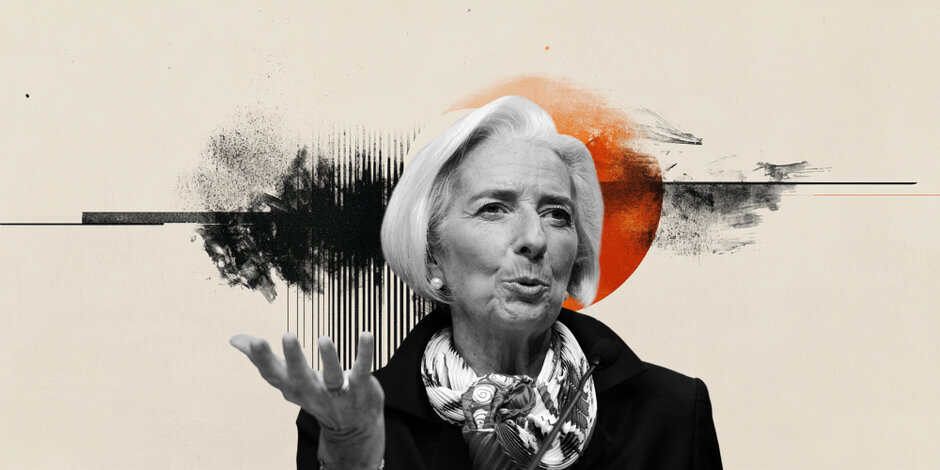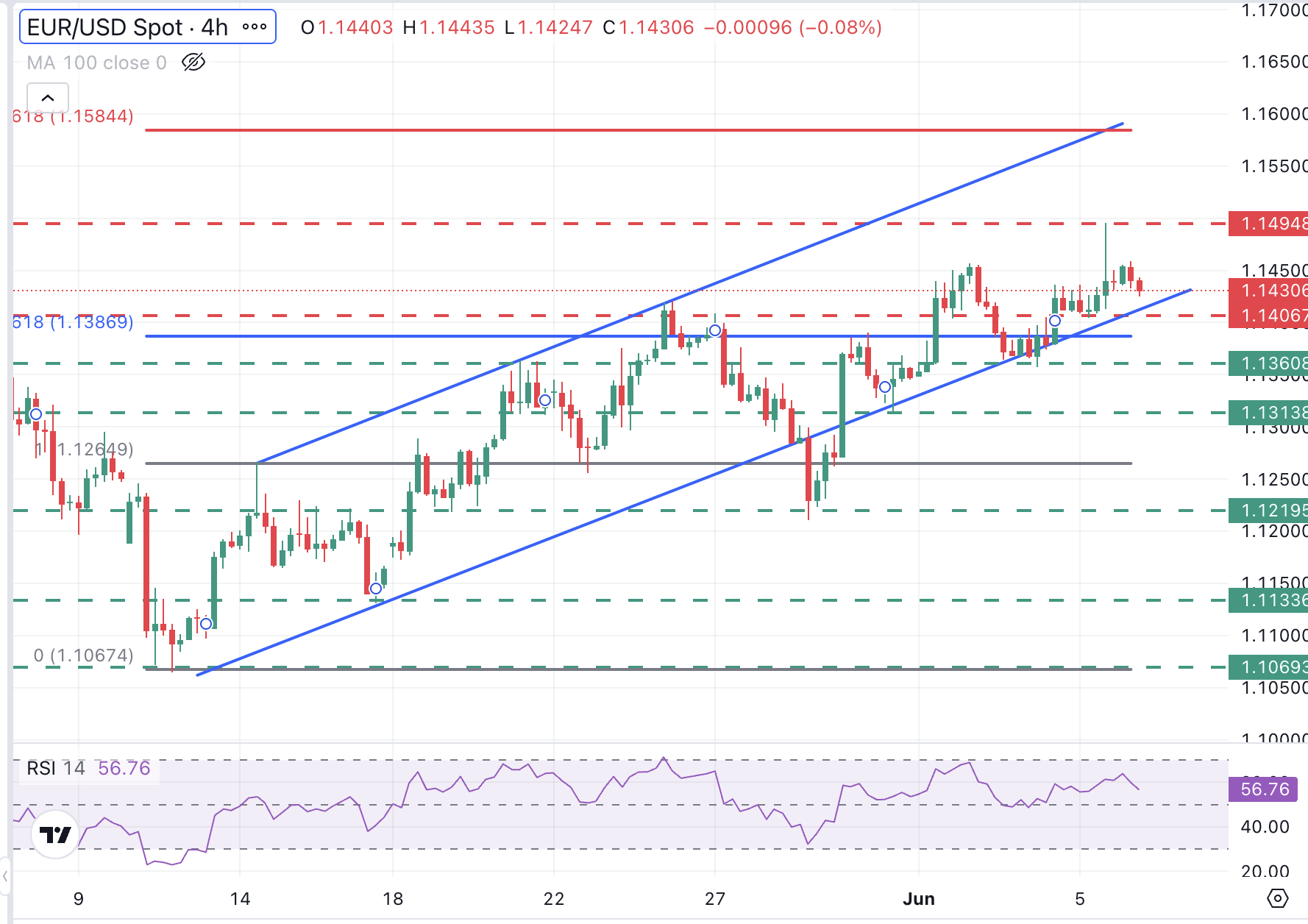Created
: 2025.06.06














![]() 2025.06.06 16:46
2025.06.06 16:46
EUR/USD is trading moderately lower on Friday, moving near the 1.1430 level at the time of writing, after having reached levels near 1.1500 the previous day. A hawkish European Central Bank (ECB) statement boosted the common currency on Thursday, but the market is turning more cautious while awaiting the US Nonfarm Payrolls (NFP) report due later.
The ECB cut interest rates by 25 basis points, lowering the key Rate On Deposit Facility to 2.0% as widely expected after Thursday's monetary policy meeting. Still, President Christine Lagarde struck an exceptionally hawkish tone, suggesting that the easing cycle might be nearly over.
Investors pared back hopes of further ECB monetary easing for the coming months, and the Euro (EUR) rallied alongside the German Treasury bond's appreciation.
The US Dollar (USD), on the contrary, remained on its back foot, weighed by a string of downbeat macroeconomic releases this week and the lack of progress in US President Donald Trump's negotiations with trading partners.
The long-awaited phone call between Trump and Chinese President Xi Jinping has failed to bring any advance on the uncertain trade relationship between the world's two major economies, but the positive comments from the republican have contributed to soothing investors.
The table below shows the percentage change of Euro (EUR) against listed major currencies today. Euro was the strongest against the Japanese Yen.
| USD | EUR | GBP | JPY | CAD | AUD | NZD | CHF | |
|---|---|---|---|---|---|---|---|---|
| USD | 0.16% | 0.16% | 0.26% | -0.08% | 0.12% | -0.12% | 0.12% | |
| EUR | -0.16% | 0.01% | 0.07% | -0.23% | -0.09% | -0.26% | -0.04% | |
| GBP | -0.16% | -0.01% | 0.04% | -0.23% | -0.09% | -0.26% | -0.05% | |
| JPY | -0.26% | -0.07% | -0.04% | -0.30% | -0.03% | -0.27% | -0.22% | |
| CAD | 0.08% | 0.23% | 0.23% | 0.30% | 0.20% | -0.03% | 0.19% | |
| AUD | -0.12% | 0.09% | 0.09% | 0.03% | -0.20% | -0.17% | 0.06% | |
| NZD | 0.12% | 0.26% | 0.26% | 0.27% | 0.03% | 0.17% | 0.22% | |
| CHF | -0.12% | 0.04% | 0.05% | 0.22% | -0.19% | -0.06% | -0.22% |
The heat map shows percentage changes of major currencies against each other. The base currency is picked from the left column, while the quote currency is picked from the top row. For example, if you pick the Euro from the left column and move along the horizontal line to the US Dollar, the percentage change displayed in the box will represent EUR (base)/USD (quote).

EUR/USD is trading on a positive trend, printing higher highs and higher lows since mid-May as seen in the 4-hour chart below. The pair found sellers at the psychological 1.1500 level on Thursday, but the overall trend remains positive despite the weaker bullish momentum.
The pair is pulling back on Friday, with investors cautious ahead of the release of the US Nonfarm Payrolls report, as prices approach a key support area at 1.1400 (round number, upward-sloping trendline). Below there, the bullish trend would be challenged, with bears focusing on 1.1360 and 1.1315, which have been acting as support and resistance since mid-April.
On the upside, resistances are at 1.1495, which limited the recovery on Thursday, and the 261.8% Fibonacci extension at 1.1585.
The European Central Bank (ECB) in Frankfurt, Germany, is the reserve bank for the Eurozone. The ECB sets interest rates and manages monetary policy for the region. The ECB primary mandate is to maintain price stability, which means keeping inflation at around 2%. Its primary tool for achieving this is by raising or lowering interest rates. Relatively high interest rates will usually result in a stronger Euro and vice versa. The ECB Governing Council makes monetary policy decisions at meetings held eight times a year. Decisions are made by heads of the Eurozone national banks and six permanent members, including the President of the ECB, Christine Lagarde.
In extreme situations, the European Central Bank can enact a policy tool called Quantitative Easing. QE is the process by which the ECB prints Euros and uses them to buy assets - usually government or corporate bonds - from banks and other financial institutions. QE usually results in a weaker Euro. QE is a last resort when simply lowering interest rates is unlikely to achieve the objective of price stability. The ECB used it during the Great Financial Crisis in 2009-11, in 2015 when inflation remained stubbornly low, as well as during the covid pandemic.
Quantitative tightening (QT) is the reverse of QE. It is undertaken after QE when an economic recovery is underway and inflation starts rising. Whilst in QE the European Central Bank (ECB) purchases government and corporate bonds from financial institutions to provide them with liquidity, in QT the ECB stops buying more bonds, and stops reinvesting the principal maturing on the bonds it already holds. It is usually positive (or bullish) for the Euro.
![]()
Created
: 2025.06.06
![]()
Last updated
: 2025.06.06

FXStreet is a forex information website, delivering market analysis and news articles 24/7.
It features a number of articles contributed by well-known analysts, in addition to the ones by its editorial team.
Founded in 2000 by Francesc Riverola, a Spanish economist, it has grown to become a world-renowned information website.
We hope you find this article useful. Any comments or suggestions will be greatly appreciated.
We are also looking for writers with extensive experience in forex and crypto to join us.
please contact us at [email protected].
Disclaimer:
All information and content provided on this website is provided for informational purposes only and is not intended to solicit any investment. Although all efforts are made in order to ensure that the information is correct, no guarantee is provided for the accuracy of any content on this website. Any decision made shall be the responsibility of the investor and Myforex does not take any responsibility whatsoever regarding the use of any information provided herein.
The content provided on this website belongs to Myforex and, where stated, the relevant licensors. All rights are reserved by Myforex and the relevant licensors, and no content of this website, whether in full or in part, shall be copied or displayed elsewhere without the explicit written permission of the relevant copyright holder. If you wish to use any part of the content provided on this website, please ensure that you contact Myforex.
Myforex uses cookies to improve the convenience and functionality of this website. This website may include cookies not only by us but also by third parties (advertisers, log analysts, etc.) for the purpose of tracking the activities of users. Cookie policy